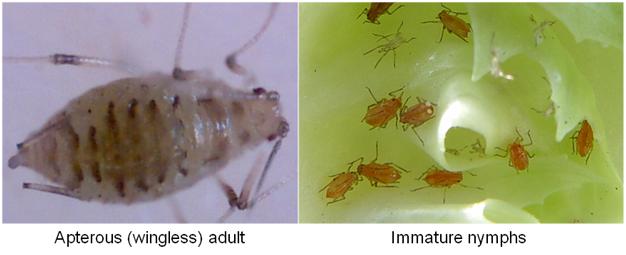 |
|
|
|

|
|||
| |
|||
Consistent with the warm weather we have been experiencing lately, Lettuce aphids, Nasonovia ribisnigri, (aka., Red aphid) are beginning to show up in desert lettuce again. In the past week, we've positively identified lettuce aphid appearing on both head lettuce and romaine in Dome Valley and Wellton. In addition, we have picked up a couple of alate (winged) lettuce aphids on the Ag Center, but no colonization of apterous (wingless) aphids has been observed yet. However, previous experience has taught us that daytime high temperatures in the high 70's and low 80's are ideal for population growth. Thus, we anticipate that lettuce aphids will begin colonizing rapidly throughout March. A few things to remember about lettuce aphids relative to the other aphids we commonly see. First, the immature nymphs are small and have a red appearance, whereas the apterous adults are typically a large brown colored aphid with dark bands running across the abdomen. Second, among the crops we grow locally, lettuce aphids are only found on the lettuce types (Lactuca spp.). Lettuce aphids prefer to colonize the terminal growth, and can often be found in heads or hearts, whereas green peach aphids are often found on the frame leaves in high numbers before moving into the heads. Sampling should be focused in the terminal growth of young plants, and in the heads and hearts of older plants. Third, they can reproduce prolifically, producing many more winged alates than other species, which can quickly lead to widespread abundance throughout a field or a growing area. Finally, as the saying goes "he who hesitates is lost". If lettuce aphids are found on your lettuce, it is recommended that you respond quickly with an insecticide treatment. The product of choice is Movento at 5 oz/ac. Because of its systemic activity, Movento will reach aphids in the protected terminal growth. Be sure to include a penetrating adjuvant for best results at a rate of at least 0.25% v/v. It normally requires 7-10 days of activity before significant reduction in the infestation is observed. For more information please refer to the bulletin: "Lettuce Aphid on Late Season Produce" Remember: When in Doubt-Scout.
To contact John Palumbo go to: jpalumbo@ag.arizona.edu
|
|||
| Back | |||
For questions or comments on any of the topics please contact Marco Pena at the Yuma Agricultural Center. |
|||
| Home | Cotton
| Veggies | Forages
| Grains | Citrus
| Crop x Crop Insects | Diseases| Weeds | Pesticides | Economics | News | Weather | Research | Photos | Contacts | General Info. Copyright © 2001 University of Arizona, College of Agriculture and Life Sciences Webmaster: Al Fournier (acis@ag.arizona.edu) |
|||
